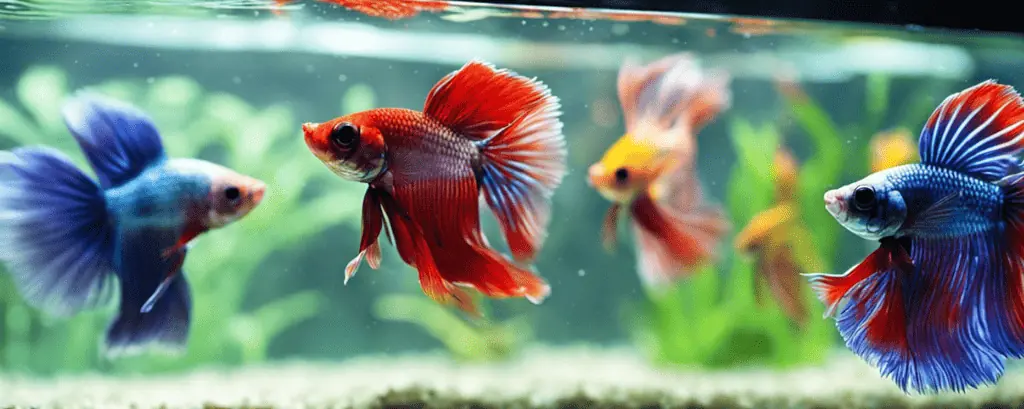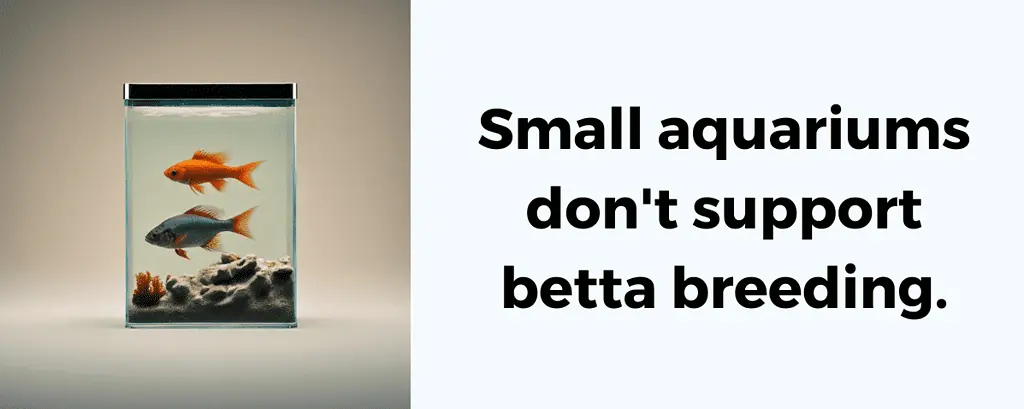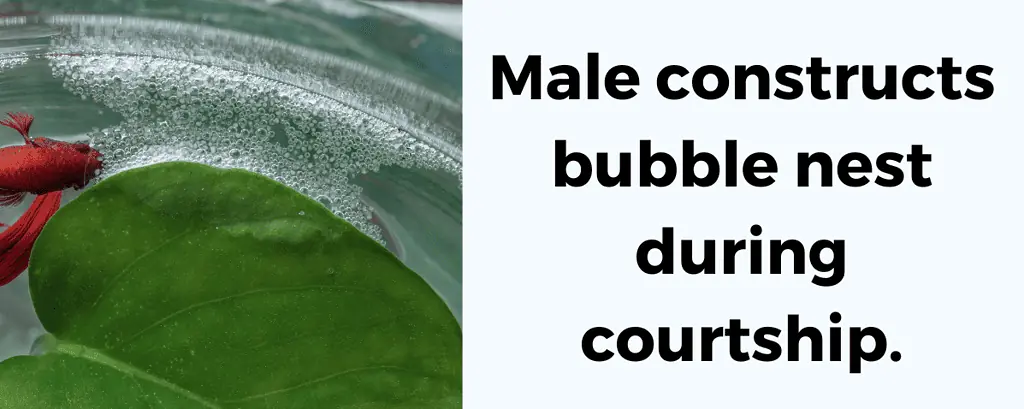The beautiful betta fish is a popular species among new fishkeepers and experienced aquarists alike.
As a fan of these captivating and intelligent fish, you’re likely interested in learning how to breed betta fish.
You may want to breed bettas for several reasons, including creating a unique appearance.
Whether you want to sell, trade, or show bettas, breeding them requires careful planning and preparation.
Bettas are not the easiest fish to breed. But with the right equipment, conditions, and knowledge, it is possible to breed these captivating fish at home.
As a veterinarian, I strive to educate pet owners on how to best care for their pets, including betta fish.
As part of this goal, I wanted to ensure you had the right information.

Table of Contents
Proper Preparation Increases Your Chance of Successful Breeding

My goal is to provide you with the information you need to support your betta fish’s health and quality of life.
This means minimizing unnecessary suffering due to incorrect breeding conditions.
Unsuitable breeding circumstances result in sick or dead bettas.
To avoid this heartache, we will discuss what equipment you need and tips to support optimal breeding conditions.
Breeding bettas is challenging.
This is in part because they are territorial and aggressive fish. They also have specific environmental needs at different stages during the breeding process.
We will review the betta breeding process step-by-step to help increase your chances of success.
#1 Establish Your Permanent Betta Tanks

Because bettas are territorial fish, you must house them in multiple separate tanks.
This includes setting up permanent aquariums for your adult bettas.
Given their aggressive behavior, housing certain betta fish together can lead to fighting and dead fish.
To prevent this, there are general rules regarding which fish and how many to house together.
Adult male and female bettas cannot live in the same permanent tank.
So, if you are planning to breed bettas, you will need at least two permanent betta fish tanks.
Adult male bettas should always be housed alone.
Females are typically considered less aggressive than males and may be kept in the same sorority tank in certain situations.
While females are capable of the aggression seen in males, housing females in groups when possible may actually decrease aggressive behavior.
Your permanent betta tanks should still include the basics of a general permanent betta aquarium used for non-breeding fish.
But some aspects are worth emphasizing when setting up permanent fish tanks for breeding bettas.
Generally speaking, we need to minimize any stress which might discourage your bettas from wanting to breed.
For example, too little aquarium space may affect breeding success.
Although wild betta fish can survive in shallow puddles, small aquariums do not support breeding in captivity.
In fact, larger tanks may help by reducing unwanted aggressive behavior during courtship.
Your bettas must be in good health to breed successfully.
Water quality and temperature affect your fish’s health and, thereby, their ability to reproduce.
Therefore, as with any permanent betta tank, you will need a filter to maintain good water quality.
Although wild bettas normally live in still water, a filter will help protect your breeding bettas from harmful levels of waste products like ammonia.
Similarly, inappropriate water temperature is bad for your fish’s immune system. This is why a water heater and thermometer are especially crucial in your bettas’ permanent tanks.
Stress may also make your bettas less inclined to breed.
An effective way to reduce stress and provide enrichment for your bettas is to incorporate plants into their aquarium.
#2 Set Up Your Betta Fish Breeding Tank

You must establish a separate breeding or mating tank for your bettas.
The purpose of a breeding tank is to provide a place for mating to occur and then, later, a safe place for the fry to live in.
Be sure you have all of the equipment to support betta fry and improve your survival rate.
Following these breeding tank recommendations is important since betta fry are fragile.
Equipment needed to set up a betta breeding tank
10 Gallon Aquarium
Since this aquarium will need to be able to accommodate your male and female, it should be at least 10 gallons big.
Do not use any substrate, like gravel, since it will make it harder for your male to find and retrieve the eggs.
Acrylic Lid
Surprisingly, bettas can jump and need a lid to keep them secure.
An acrylic lid will also help achieve the higher humidity levels needed during breeding (90% humidity in breeding tanks).
Humidity is important to keep your bettas’ bubble nest intact. You may also consider adding plastic wrap to your tank to help maintain humidity.
Removable, Clear Tank Divider
This will allow your male and female to see each other but not interact.
This is crucial to gradually introduce the pair safely and prevent them from fighting.
Submersible Water Heater & Thermometer
These are necessary to maintain a water temperature between 77-82° degrees Fahrenheit (25-28° C), which is best for mating.
Sponge Filter with Adjustable Flow Rate
A filter will help keep the water clean by reducing harmful waste and bacteria.
Sponge filters are excellent because they provide mechanical and biological filtration while oxygenating the water.
Bettas are not strong swimmers, so choosing an adjustable filter with a gentle flow is important.
If the filter is too strong, it can cause your fish stress, fatigue, and damage their fins.
Air Pump
This will power your sponge filter by using air bubbles to pull water through the sponge.
LED Lighting
There is not much information regarding the best lighting conditions for breeding bettas.
But some breeders have successfully used artificial lighting to create a light-dark cycle consisting of 14 hours of light and 10 hours of darkness.
This is based on the day length in their natural habitat in Southeast Asia.
Bubble Nest Substrate
You need to add something at the surface of your aquarium for your male to build his bubble nest under.
Options include a floating piece of Indian almond leaf or a small piece of styrofoam.
Live or Silk Plants
Plants help mimic bettas’ natural habitat and serve as hideouts to reduce stress.
They give the female a place to hide from the male if she feels stressed during the courting process and, later, for the fry to hide as they grow.
Live plants, like Amazon Sword, also help remove harmful ammonia from the water.
Artificial options, like silk plants, are appropriate if you avoid toxic or sharp materials.
After gathering all of the necessary equipment, you will need to decide where to place your breeding tank.
Your breeding aquarium should be positioned somewhere quiet and isolated from other aquariums.
The goal is to eliminate any distractions which may discourage breeding.
#3 Pick Your Breeding Pair of Betta Fish

Selecting a healthy and compatible pair of bettas is a crucial step in successful breeding.
Fish keepers may either buy bettas from a breeder or a pet store. Whichever source you choose, it must be a reputable seller.
Generally, breeders are preferred since they will have more detailed information about the age and health of their fish.
Choose a breeding pair with physical characteristics you want to produce in their offspring.
Younger bettas are generally better suited for breeding.
Bettas reach sexual maturity at about 16 weeks old and have a captive lifespan of about two years. Thus, breeding is more successful when your mating pair is between 16 to 40 weeks old.
Bettas can only mate so frequently. Therefore, do not pick bettas who have mated recently, especially within the last four weeks.
Avoid picking fish with deformities or noticeable signs of illness, like Ichthyophthirius multifiliis (aka “ich”) or low energy, since they will be less fit for breeding.
If possible, choose a gravid female who already appears to be carrying eggs. Additionally, some experienced betta breeders recommend choosing a male who has already built bubble nests.
#4 Creating the Perfect Breeding Conditions for Betta Fish

The goal is to breed your bettas when they are at peak health and fitness.
As with any pet, nutrition and stress can hugely impact overall health and, thus, their ability to breed.
So, to best prepare your adult bettas for breeding, providing excellent nutrition before and throughout the breeding process is important.
This means providing a nutritious diet for at least a couple of weeks before moving your mating pair to the breeding tank.
Siamese fighting fish are carnivores who usually eat near the surface. In the wild, they eat insects and larvae, but in captivity, they eat protein-rich foods in various forms.
Betta fish food may be live, frozen, freeze-dried, pellets, or flakes.
Live bloodworms are a good choice because of their high protein content.
Scientists recommend feeding a combination of live food and commercial pellets or flakes.
Feed your bettas twice a day and no more. These should be small amounts since overfeeding, and uneaten food increases harmful waste products, like ammonia.
#5 How to Introduce Your Bettas

You must keep your male and female betta fish separate until they are both ready to be introduced to each other. Rushing this process can make breeding unsuccessful.
Add the female to the tank first and then the male, but keep a tank divider in there.
Let her acclimate to the water and her new surroundings for about 30 minutes.
Once the female has had time to get used to the breeding tank, you may add the male betta to the opposite side of the divider.
The male and female can see each other through the clear divider. This divided tank setup will allow them to get acquainted safely.
After seeing each other, the male and female will undergo physical changes if they are receptive to each other.
Although they cannot physically interact with each other, the male and the female will show they are ready to mate by changing their color.
The male’s coloration will become bolder and more vibrant.
As the female becomes receptive to the male, her overall color will become darker and more intense. She will also replace her usual horizontal stripes with vertical ones.
It may take two weeks or so for your pair to get accustomed. Patience is crucial because fish will not mate if they are uncomfortable with each other.
During this time, observe the pair to confirm they look healthy and active enough for breeding.
#6 Betta Bubble Nests

The male will construct a bubble nest as part of the courtship process.
Using his saliva, the male will collect air and build a nest of bubbles near the surface.
This is an exhausting process and may take hours before the male is satisfied with his work.
The bubble nest serves two purposes. It allows the female to judge whether the male is suitable and fit enough to breed with her.
Then later, the nest will protect the eggs until they hatch.
#7 Allow Your Betta Fish to Breed

Once your bettas have changed color, and the male has finished building the bubble nest, it is time to let them breed.
Remove the Tank Divider and Monitor for Inappropriate Aggressive Behavior
Once your pair has displayed the physical characteristics indicating readiness for breeding, you may remove the tank divider.
Now, your female betta can evaluate the bubble nest to check if it is suitable.
The male will attempt to guide her toward the nest if she hesitates.
You must monitor your bettas closely during this time because the male can become aggressive while seeking the female’s approval.
Your female may swim away from the nest or even destroy it if it is not up to her standards.
A good deal of chasing is considered normal pre-mating behavior.
However, you may need to intervene and remove the female if you observe inappropriate aggressive biting.
If your fish are too aggressive toward each other, they may not be compatible.
As long as the pair are not hurting each other, it is best not to disturb them. This includes avoiding feeding during this time.
Watch for Courtship Behavior to Confirm Your Bettas are Mating

Once the female approves of the nest, she will slowly swim toward it and stay near the male. This serves as an invitation for the male to begin the mating dance.
The male will circle the female, and the pair will engage in a series of embraces. During each embrace, the female will release eggs so the male can fertilize them.
During the mating period, the pair may alternate between holding each other, rolling over, and temporarily going limp.
These are all normal mating ritual behaviors, even the “dead fish” position.
The male betta will periodically retrieve the eggs and move them to the bubble nest.
This process can last up to a few hours and results in an average of 200 to 300 eggs per mating.
Remove Your Female Betta as Soon as Mating Is Complete
Once they stop embracing, the male will post up under the nest, and the female will avoid him.
You must immediately remove the female from the breeding tank as soon as this happens.
Removing the female prevents her from eating the eggs and keeps her safe from the male, who will become very protective of the eggs.
#8 Let the Male Betta Watch Over the Eggs

Following mating, the male betta will spend the next couple of days maintaining the nest and tending to the eggs until they hatch.
The male will collect fallen eggs and return them to the nest.
He will also fan the nest with his fins to provide oxygen to the eggs.
#9 Hatching Betta Fry

Betta eggs should hatch in about one to two days. You may notice the bubble nest shake as the fry hatch.
Fry, or baby fish, cannot swim right away.
During this time, they may drift out of the bubble nest. The male will catch them and put them back in the nest to keep them safe.
About two to three days after hatching, the betta fry should be able to swim on their own.
At this point, the male may start to view his offspring as a threat and eat them.
To prevent this, you must remove the adult male from the breeding tank as soon as the babies can swim.
Good nutrition is essential while the betta fry is growing.
Initially, you may feed live microworms and infusoria, which are tiny aquatic organisms.
As your baby bettas grow larger, transition them to larger foods, such as baby brine shrimp.
At about three months old, your bettas will have noticeable changes to their coloration and fins. These differences will help you distinguish the males from the females.
This is your signal to start separating your bettas into individual tanks to prevent aggression and fighting.
Breeding Bettas Requires Careful Planning and Preparation

Breeding bettas is not simple.
It is a long process requiring specific environmental conditions and weeks of careful observation.
Additionally, bettas pose a unique challenge because of their territorial and aggressive behavior.
Breeding these beautiful fish might seem intimidating, but at-home breeding is possible if you take the time to plan appropriately.
If you found this article useful, share it on social media to help your fellow betta fish lovers!
FAQ On Breeding Bettas

How many babies do breeding betta fish have?
Betta fish may lay between a dozen to 400 eggs during a given mating. But on average, a single spawning event results in 200 to 300 eggs.
Bettas can start breeding once they are about four months old and can spawn as frequently as every four weeks. Surprisingly, betta fish only need around three days to hatch into fry.
For those of you good at math, this means if you breed them often, expect around 2400 eggs per year. I wouldn’t advise this, as breeding is stressful on your bettas. And think about it; do you really want 2,400 betta fry?
How do I know if my female betta is ready to breed?
A female betta who is ready to breed will have a darker color. If she is ready to mate, her body will have light, vertical stripes instead of her usual dark, horizontal stripes.
Her belly may also be slightly enlarged if she is gravid with eggs. Her ovipositor will also be more visible. It shows up as a white speck around her ventral fins.
You can also tell by her behavior toward the male when put together.
If she’s ready to mate, she’ll “flirt” with him by flaring her fins and wiggling her body.
How many betta fry will survive?
Under appropriate conditions, the survival rate of betta fry may be over 90%.
If more than 10% of your betta fry are dying, it could be due to several reasons, most of which are environmental:
– Poor water conditions
– Poor diet
– Maintenance issues
– Parasites in the water
– Chemical toxins
– pH levels are wrong
– Ammonia and Nitrates are elevated
Fix these issues to give your fry a better chance at survival. Of course, one of the biggest elements is the size of your tank. Make sure the tank is 10 gallons large.
If you have multiple spawns, you’ll need even more. Keep this in mind before deciding to breed in the first place.
Why is my male betta eating the eggs?
Your adult male betta may eat eggs if they are unfertilized or if they have some other abnormality.
Additionally, if your male is not getting enough energy from his normal food, he may eat eggs. First-time fathers or overly aggressive fish may also exhibit unwanted behavior like egg-eating.
Stress also contributes to this. Stressed-out fish burn more energy and feel the need to take in more food. If you’re not giving them more food, they’ll find it in another (cannibalistic) way.
Ensure they have enough foliage to provide them with hiding spots to destress and keep the tank away from the loud and bright parts of your home.


